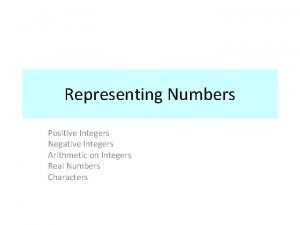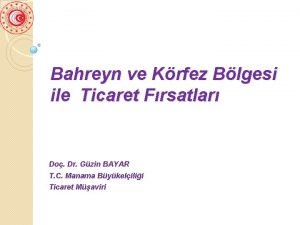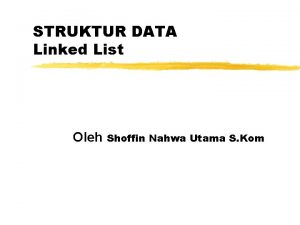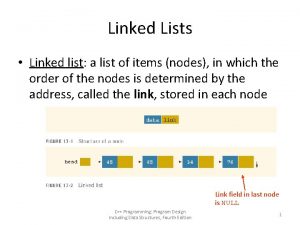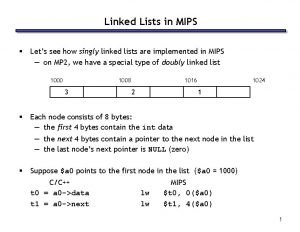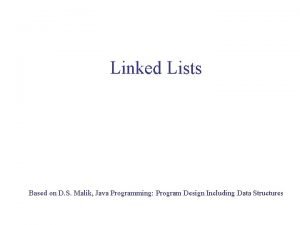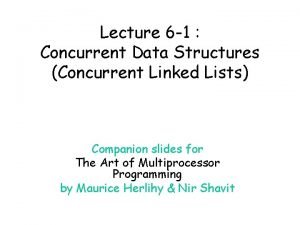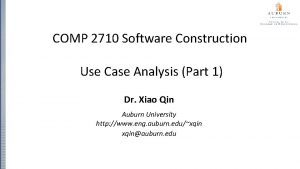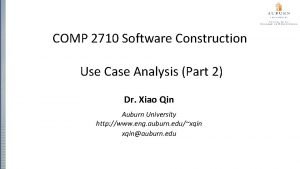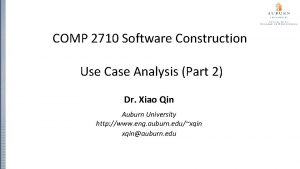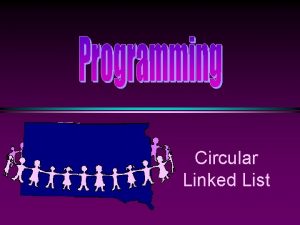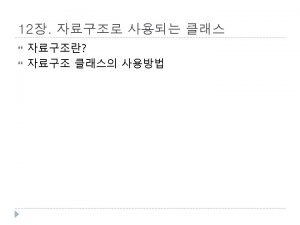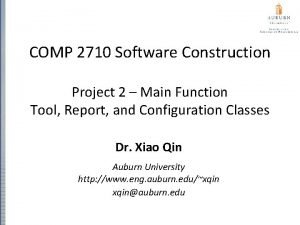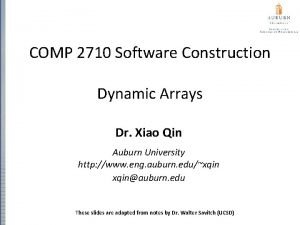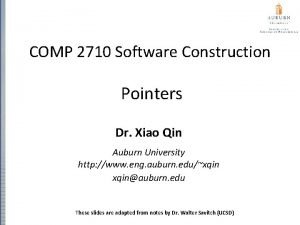COMP 2710 Software Construction Linked List Exercises Part



















- Slides: 19

COMP 2710 Software Construction Linked List – Exercises: Part 1 Dr. Xiao Qin Auburn University http: //www. eng. auburn. edu/~xqin@auburn. edu

Review: Structure Types • Define struct globally (typically) • No memory is allocated – Just a "placeholder" for what our struct will "look like" • Definition: struct CDAccount. V 1 Name of new struct "type" { double balance; member names double interest. Rate; int term; }; 6 -2

Review: Define Pointer Types • Pointers are "typed" – double *p; • Can "name" pointer types • typedef int* Int. Ptr; – Defines a "new type" alias – Consider these declarations: Int. Ptr p; int *p; • The two are equivalent 10 -3

Review: The new Operator p 1 = new int; • Creates new "nameless" variable, and assigns p 1 to "point to" it • Can access with *p 1 – Use just like ordinary variable 10 -4

Avoid Dangling Pointers delete p; • Destroys dynamic memory • But p still points there: Called "dangling pointer" • If p is then dereferenced ( *p ) – Unpredicatable results! – Often disastrous! • Avoid dangling pointers: Assign pointer to NULL after delete: delete p; p = NULL; 5

Review: Nodes and Pointers struct list_node_t { string item; int count; List. Node *link; }; typedef list_node_t* list_node_ptr_t; 17 -6

Exercise 1. Can you design a head node? struct list_head_t { string listname; int max; int min; list_node_ptr_t head; }; • "head" is not a node: struct list_node_t List. Node. Ptr head; { string item; pointer to a node – A simple int –count; Set to point to 1 st node in list_node_t *link; • Head used to "maintain" start of list }; • Also used as argument to functions typedef list_node_t* list_node_ptr_t; How to maintain metadata of the list? (What is metadata? ) 7

Exercise 2: Print a list of nodes struct node_t { int data; node_t *next; }; typedef node_t* node_ptr_t; void print_list(node_ptr_t root); Hint: You should consider two cases

Answer: Print a list of nodes void print_list(node_ptr_t root) { node_ptr_t cur; if (root == NULL) /* case 1 */ cout << "This is an empty listn"; cur = root; /* case 2 */ while (cur != NULL) { cout << cur->data << endl; cur = cur->next; } }

Exercise 3. Insert a node to the head of the list Tip: Apply this solution to homework 5. struct node { int data; node *next; }; typedef node* node_ptr_t; What is the difference between these two prototypes? void insert_node(node_ptr_t& root, int info); //Another possible prototype void insert_node(node_ptr_t& root, node_ptr_t new_node_ptr); How many cases should we consider? What are these cases?

Exercise 3 - Insert a node to the head of the list struct node { int data; node *next; }; typedef node* node. Ptr; void insert. Node(node. Ptr& root, int info); root 6 5 1 cur_ptr info 2 3 4 1 -11

Exercise 3: Insert a node to the head of the list void insert_node(node_ptr_t& root, int info) { node_ptr_t cur_prt; cur_ptr = new node; //Do not use this: new node. Ptr assert(cur_ptr != NULL); //Ensure that memory is allocatd cur_ptr->data = info; cur_ptr->next = NULL; if (root == NULL) //For empty list, cur_ptr becomes the root = cur_prt; else { //Insert cur as the root of the list cur_ptr->next = root; root = cur_ptr; } }

Exercise 4. Insert a node to the end of the list struct node_t { int data; node_t *next; }; typedef node_t* node_ptr_t; void append_node(node_ptr_t& root, int info); How many cases should we consider? What are these cases? 1 -13

Exercise 4 - Insert a node to the end of the list struct node_t { int data; node_t *next; }; typedef node_t* node_ptr_t; void append_node(node_ptr_t& root, int info); root 6. 1 5 cur_ptr 1 6. 2 new_ptr info 2 3 4 14

void append. Node(node_ptr_t& root, int info) { node_ptr_t new_ptr; node_ptr_t cur_ptr; new_ptr = new node; //Do not use this: new node. Ptr assert(new_Ptr != NULL); //Ensure that memory is allocated new_ptr->data = info; new_ptr->next = NULL; if (root == NULL) //For empty list, new_ptr becomes the root = new_ptr; else { //Append the new node at the end of the list cur_ptr = root; while (cur_ptr->next != NULL) cur_ptr = cur_ptr->next; cur_ptr->next = new_ptr; } }

Exercise 5. Delete the head node of the list struct node_t { int data; node_t *next; }; typedef node_t* node_ptr_t; void delete_head(node_ptr_t& root); How many cases should we consider? What are these cases? 1 -16

Exercise 5 - Delete the head node of the list struct node { int data; node *next; }; typedef node* node. Ptr; void delete. Head(node. Ptr& root); root 2 3 1 cur. Ptr 17

Exercise 5. Delete the head node of the list void delete_head(node_ptr_t& root) { node_ptr_t cur_ptr; if (root != NULL) { cur_ptr = root; root = root->next; /* Deleted node must be returned to OS */ delete cur_ptr; } else cout << "This is an empty list. No deletion!n"; }

Summary • Node is struct or class object • Insert a node to the head of the list • Insert a node to the end of the list • Delete the head node of the list
 Singly linked list vs doubly linked list
Singly linked list vs doubly linked list Introduction to linked list
Introduction to linked list Single linked list adalah yang paling dari semua varian
Single linked list adalah yang paling dari semua varian 2710 19 43
2710 19 43 Ascii stands for
Ascii stands for 2710 gtip
2710 gtip Generic linked list java
Generic linked list java Jenis linked list
Jenis linked list Singly vs doubly linked list
Singly vs doubly linked list Polynomial addition using singly linked list in c
Polynomial addition using singly linked list in c Tan is a lover of linked list
Tan is a lover of linked list Xor linked list c
Xor linked list c C++ list
C++ list Linked list in mips
Linked list in mips Linked list definition
Linked list definition Linked list uml
Linked list uml Advantages and disadvantages of circular linked list
Advantages and disadvantages of circular linked list Malloc linked list
Malloc linked list Circular single linked list adalah
Circular single linked list adalah Concurrent linked list
Concurrent linked list




